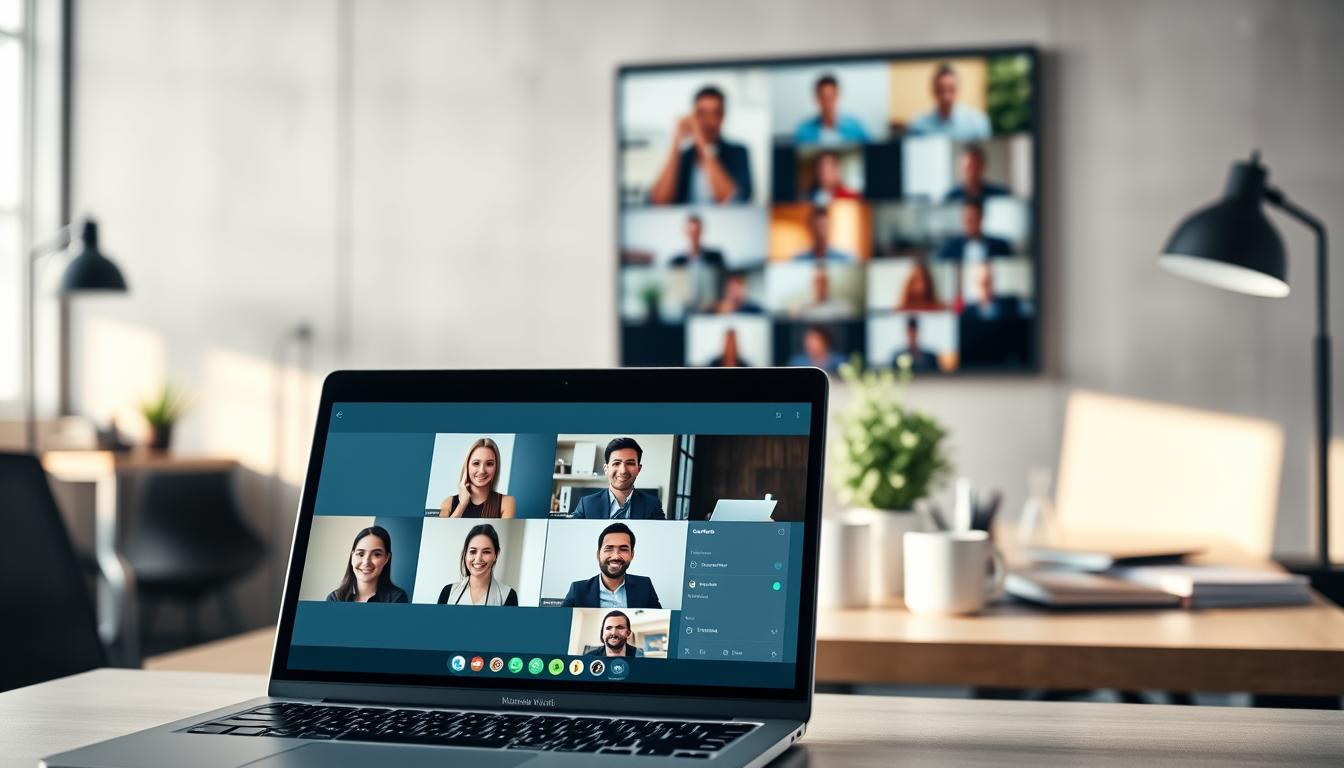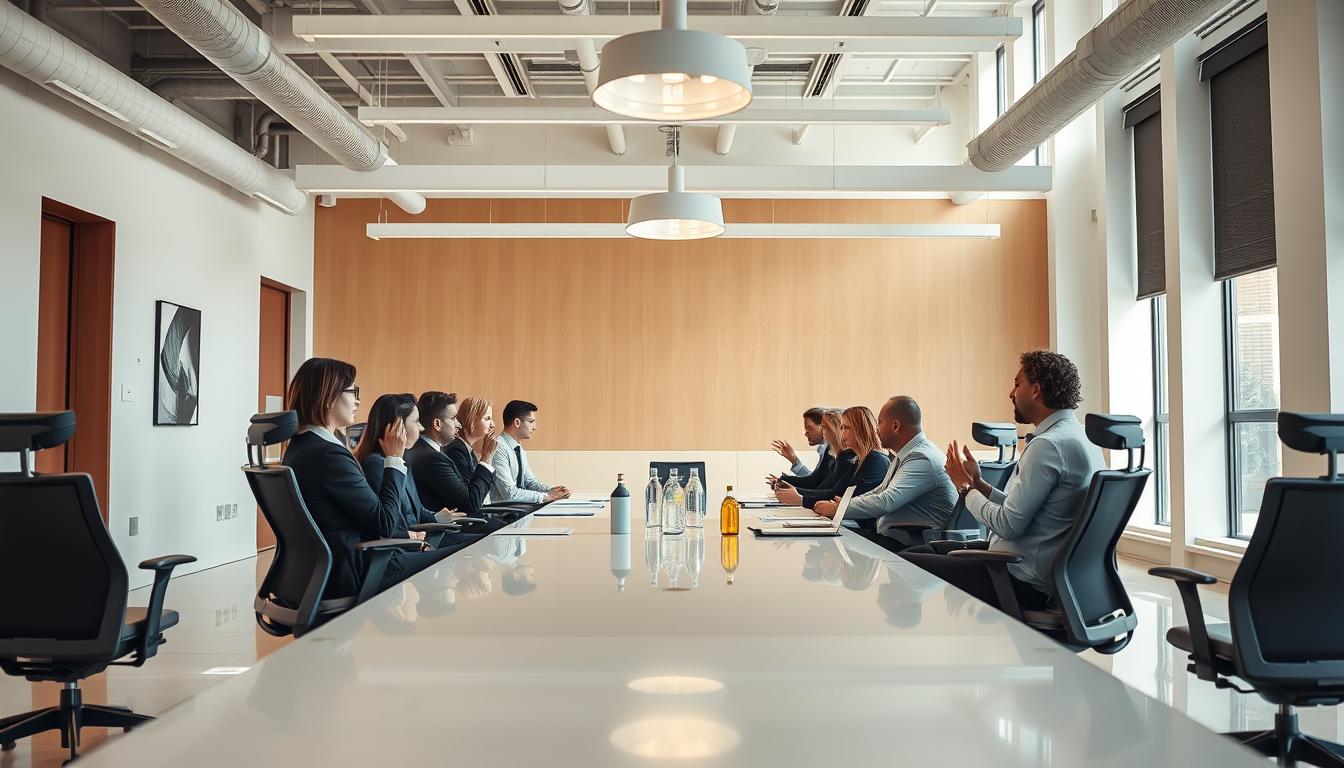In today’s fast-paced work environment, it’s vital to have effective meetings. These meetings boost productivity and teamwork in small groups. Experts say workers spend about 21% of their time in meetings, but many are unproductive. We’ll share strategies that make meetings a time for great ideas and decisions, not a burden.
This guide focuses on making meetings useful and interesting. We’ll talk about the importance of clear goals, planned agendas, and encouraging everyone to participate. Using these tips can make your meetings more productive. This creates a better atmosphere for the whole team.
Understanding the Importance of Effective Meetings
Effective meetings are key to boosting team work and achieving project goals. They are used for making decisions, sharing important details, and building team spirit. Clear goals turn meetings into valuable productivity tools.
Many don’t see the true value of well-run meetings. A good meeting culture turns time together into chances for real connection. Teams focused on quality meetings handle challenges better and grab opportunities. But without a clear purpose, meetings can lead to frustration.
Teams should use active engagement and clear goals to make meetings worthwhile. This improves morale and work performance. It also builds a meeting culture where everyone feels open to share and solve problems together. This is crucial for reaching company aims.
Identifying Objectives for Team Meetings
It’s key to set clear goals for any team meeting. Good goals show what the team plans to do, like brainstorming, agreeing on project goals, or making key decisions. Knowing these goals early helps keep chats focused and on point.
Understanding the aim of the meeting gets everyone involved and responsible. This clarity means all are working together towards common goals. Teams that set clear meeting goals usually find they get more done and talk more effectively.
Best Practices for Internal Meetings in Small Teams
Putting the right practices in place for team meetings can boost teamwork and get more done. It’s all about planning and doing meetings the right way. With a clear plan and structure, your team can make the most of the time you spend together.
Clarifying Meeting Aims and Purposes
It’s important to know why you’re meeting before you start. You need to figure out what the team aims to achieve. Knowing what you want out of the meeting helps everyone come prepared and keeps the conversation focused.
Establishing a Clear Agenda
For meetings to work well, you need a clear agenda. Start each agenda item with an action word to set clear expectations. This helps everyone stay on point and makes it clear what needs to happen next.
Setting Time Allocations for Agenda Items
Keeping everyone engaged means watching the clock for each agenda item. This keeps discussions on track and makes meetings more effective. A well-organized agenda with set times helps avoid side-tracking into less important topics.
Creating Actionable Meeting Agendas
It’s crucial to make meeting agendas that lead to action. A good agenda gets everyone involved and keeps the conversation on track. When making an agenda, start with action-based items. This makes the team take action, allowing everyone to add value.
Framing Agenda Items with Action Words
Action words in agenda items make the goals clear. Some examples are:
- Discuss team roles and responsibilities
- Brainstorm solutions for current challenges
- Review project timelines and deadlines
These phrases help everyone know what to do and line up with the meeting plan.
Involving Team Members in Agenda Creation
Creating the agenda with the team helps everyone feel involved. Asking for their ideas means the agenda covers what’s important to them. This makes meetings more open and useful for all.
Distribution of Meeting Agendas
Sharing the agenda early is important. Giving it out a day ahead gives the team time to get ready. Proper sharing sets the stage and encourages everyone to bring their best ideas. This leads to better talks and makes the meeting more effective.
Collaborative Tools for Meeting Management
Effective collaborative tools can make meeting management much better. Platforms such as Confluence and Asana are key for managing meetings. They help teams document notes, agendas, and tasks easily. This software lets team members work together smoothly, no matter where they are.
With the best tools, teams can keep an eye on project progress. They make sure everything decided in meetings is written down. This cuts down on misunderstandings and helps teams be responsible. Using collaborative software in meetings leads to better organization and more productivity.
Assigning Roles for Meeting Efficiency
Assigning specific roles makes meetings work better. When everyone knows their job, the meeting runs smoothly. This lets everyone pay more attention to the discussion.
Defining Responsibilities: Leader, Facilitator, Recorder
The leader keeps the meeting focused on its goals. The facilitator helps keep the conversation on track. A recorder writes down important points and actions. These roles make meetings clear and keep people responsible.
Utilizing the Timekeeper Role
A timekeeper helps keep the meeting on schedule. They watch how long each topic takes. This helps meetings be more productive. Changing roles helps everyone learn and stay involved.
Engaging Team Members During Meetings
Making meetings engaging is key for productivity and team morale. A friendly atmosphere encourages everyone to share ideas. Adding light music or starting with an icebreaker can make a big difference.
Setting the Meeting Tone and Atmosphere
Starting with a positive tone is crucial for good communication. Make team members feel at ease with relaxed seating and appealing visuals. A carefully planned atmosphere promotes openness and keeps everyone engaged.
Techniques for Encouraging Participation
Creating an interactive environment supports active participation. Use open-ended questions to start conversations. Letting team members share their views leads to deeper discussions. Recognizing their input makes them feel valued and more connected to the meeting.
Using Interactive Tools to Engage Attendees
Adding interactive tools makes meetings more engaging. Using Miro or Zoom’s breakout rooms can spice up brainstorming. These tools not only liven up discussions but also help build stronger bonds within the team, enhancing the meeting experience.
Post-Meeting Follow-Up Practices
Good follow-up after meetings makes sure we get real results from our discussions. It starts by taking accurate notes at the meeting. Then, we create summaries that highlight the main points and decisions.
Sending out these summaries quickly helps everyone stay on the same page. It’s important for keeping the team informed and in agreement on what was discussed.
Next, we need to give team members specific tasks. This helps everyone know what they are responsible for and when they need to do it. By setting clear tasks with deadlines, we make sure things get done on time. This careful follow-up and managing tasks well helps our team do what we plan and reach our goals.
Evaluating Meeting Effectiveness
Figuring out if meetings work well is key to making teams better. Looking closely at meetings helps us see what works and what doesn’t. This way, we can keep improving.
Collecting Feedback from Team Members
It’s important to know how team members feel about meetings. You can do this by:
- Talking right after meetings to get first thoughts.
- Using surveys that ask for honest opinions on the meetings.
- Getting anonymous tips so everyone can speak their mind.
Implementing Changes Based on Feedback
Making changes based on what people say can make meetings better. You might change how often you meet or how you keep everyone involved. When you listen and act on what your team says, it shows they matter. This makes your team stronger and more together.
Improving Future Meetings
Improving meetings is key to better teamwork and productivity. It’s important to regularly check meeting structure and how often they happen. This means figuring out if some meetings should be shorter, canceled, or changed. This makes our time and resources used better.
Reviewing Meeting Structure and Frequency
Here’s how to make meetings better:
- Check if you’re having meetings as often as needed, based on the project and the team’s flow.
- Look closely at the agenda of each meeting. See if they really help, or just go over the same things without solving anything.
- Think about whether shorter, more frequent meetings could keep everyone more engaged than long ones that might not be as productive.
Identifying Areas for Improvement
To improve meetings, start by looking at past ones for things to make better. Here are steps to do this:
- Ask team members for their thoughts on what’s good and what’s not in meetings.
- Search for topics that keep coming up, which might mean more information or a different way to make decisions is needed.
- Use what you learn to find ways to make future meetings more engaging and productive.
Tips for Starting and Ending Meetings on Time
Starting and ending meetings on time is key. It helps us use our time better and keeps everyone interested. To increase how productive meetings are, start on time and stay on topic.
Strategies for Timely Start
Here are ways to make sure your meetings start when they should:
- Set alarms or reminders for yourself and your team.
- Communicate meeting times clearly in advance.
- Prepare materials beforehand to avoid delays.
Maintaining Time Discipline During Discussions
Keeping discussions on point is important. Use these tips to help manage your meeting time:
- Designate specific time slots for each agenda item.
- Encourage concise contributions from all participants.
- Utilize a timer to keep discussions focused and on schedule.
Leveraging Technology for Enhanced Meetings
Today’s meetings are vastly improved with technology. Tools like Zoom and Microsoft Teams help everyone talk easily, no matter where they are. These tools help keep everyone interested and focused during meetings by offering video chats and interactive features.
Choosing the Right Virtual Tools
It’s crucial to pick the right virtual tools for effective meetings. Consider these options:
- Zoom: Offers video conferencing with record capabilities.
- Microsoft Teams: Integrates with Office tools for streamlined collaboration.
- Slack: Provides real-time messaging and project management capabilities.
Using these platforms improves involvement and reduces misunderstandings.
Utilizing Project Management Software
Project management software makes meetings more productive. Tools like Trello and Asana help manage agendas, assign tasks, and meet deadlines. This ensures everyone knows their responsibilities and follows the team’s goals.
Bringing technology into meetings boosts teamwork and keeps communication clear. This makes it simpler for teams to be productive and connected, during and after meetings.

Fostering a Positive Meeting Culture
Creating a positive culture in meetings is key to good team communication. It makes everyone feel important and ready to share. This culture is built on respectful talking, where all views are valued.
Promoting Respectful Communication
To promote respect, teams must listen and accept everyone’s ideas. This creates a space where people want to speak up. It helps avoid misunderstandings and makes teamwork better.
Encouraging a Safe Environment for Sharing Ideas
It’s important for teams to feel safe when sharing ideas. Leaders should make sure ideas are kept private and respected. This makes team members bold, sharing freely, which leads to creative solutions.
Conclusion
Putting best practices into action for team meetings can really boost productivity and teamwork. When meetings are efficient, everyone stays focused and works better together. This way of working makes sure we solve problems creatively.
Team leaders should always look for ways to make meetings better. They should listen to what their team says and use that feedback. A set of guidelines on running effective meetings can help teams stay on track in a fast-paced work world. The goal is to build a culture where everyone works well together and achieves great things.
By adopting these tips, teams will see better cooperation and engagement. This sets the stage for making smart choices quickly and becoming a tighter-knit group. With well-planned meetings, small teams can reach new heights of success.



